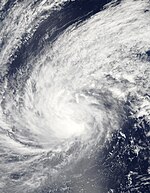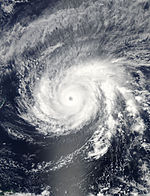2015 Pacific typhoon season
| 2015 Pacific typhoon season |

Season summary map
|
| Seasonal boundaries |
| First system formed |
January 2, 2015 |
| Last system dissipated |
December 23, 2015 |
| Strongest storm |
|
| Name |
Soudelor |
| • Maximum winds |
215 km/h (130 mph)
(10-minute sustained) |
| • Lowest pressure |
900 hPa (mbar) |
| Seasonal statistics |
| Total depressions |
40 |
| Total storms |
27 official, 1 unofficial |
| Typhoons |
18 |
| Super typhoons |
9 (unofficial)
|
| Total fatalities |
254 total |
| Total damage |
$10.2 billion (2015 USD) |
| Related articles |
|
|
Pacific typhoon seasons
2013, 2014, 2015, 2016, 2017
|
| Severe tropical storm (JMA) |
| Category 1 typhoon (SSHWS) |
|
|
| Duration |
January 13 – January 21 |
| Peak intensity |
110 km/h (70 mph) (10-min) 975 hPa (mbar) |
| Typhoon (JMA) |
| Category 4 super typhoon (SSHWS) |
|
|
| Duration |
February 6 – February 12 |
| Peak intensity |
165 km/h (105 mph) (10-min) 940 hPa (mbar) |
| Tropical storm (JMA) |
| Tropical storm (SSHWS) |
|
|
| Duration |
March 10 – March 21 |
| Peak intensity |
85 km/h (50 mph) (10-min) 990 hPa (mbar) |
| Typhoon (JMA) |
| Category 5 super typhoon (SSHWS) |
|
|
| Duration |
March 26 – April 7 |
| Peak intensity |
195 km/h (120 mph) (10-min) 910 hPa (mbar) |
| Tropical storm (JMA) |
| Tropical storm (SSHWS) |
|
|
| Duration |
April 2 – April 6 |
| Peak intensity |
65 km/h (40 mph) (10-min) 998 hPa (mbar) |
| Typhoon (JMA) |
| Category 5 super typhoon (SSHWS) |
|
|
| Duration |
May 2 – May 12 |
| Peak intensity |
205 km/h (125 mph) (10-min) 920 hPa (mbar) |
| Typhoon (JMA) |
| Category 5 super typhoon (SSHWS) |
|
|
| Duration |
May 6 – May 20 |
| Peak intensity |
185 km/h (115 mph) (10-min) 925 hPa (mbar) |
| Tropical storm (JMA) |
| Tropical storm (SSHWS) |
|
|
| Duration |
June 19 – June 25 |
| Peak intensity |
85 km/h (50 mph) (10-min) 985 hPa (mbar) |
| Typhoon (JMA) |
| Category 4 typhoon (SSHWS) |
|
|
| Duration |
June 29 – July 13 |
| Peak intensity |
165 km/h (105 mph) (10-min) 935 hPa (mbar) |
The 2015 Pacific typhoon season was a slightly above average season that produced 27 tropical storms, 18 typhoons and nine super typhoons. The season ran throughout 2015, though most tropical cyclones typically develop between May and October. The season's first named storm, Mekkhala, developed on January 15, while the season's last named storm, Melor, dissipated on December 17. The season saw at least one named tropical system forming in each of every month, the first time since 1965. Similar to the previous season, this season saw a high number of super typhoons. Accumulated cyclone energy (ACE) during 2015 was extremely high, the second highest since the 1970, and the 2015 ACE has been attributed in part to anthropogenic warming.
The scope of this article is limited to the Pacific Ocean to the north of the equator between 100°E and 180th meridian. Within the northwestern Pacific Ocean, there are two separate agencies that assign names to tropical cyclones which can often result in a cyclone having two names. The Japan Meteorological Agency (JMA) will name a tropical cyclone should it be judged to have 10-minute sustained wind speeds of at least 65 km/h (40 mph) anywhere in the basin, whilst the Philippine Atmospheric, Geophysical and Astronomical Services Administration (PAGASA) assigns names to tropical cyclones which move into or form as a tropical depression in their area of responsibility located between 135°E and 115°E and between 5°N–25°N regardless of whether or not a tropical cyclone has already been given a name by the JMA. Tropical depressions that are monitored by the United States' Joint Typhoon Warning Center (JTWC) are given a number with a "W" suffix.
...
Wikipedia



















